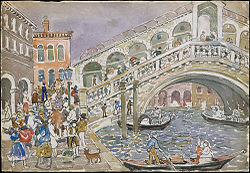Rialto Bridge
The Rialto Bridge (Italian: Ponte di Rialto) spans the Grand Canal in Venice. It is the oldest bridge across the canal and probably the most famous in the city.
The first dry crossing of the Grand Canal was a pontoon bridge built in 1181 by Nicolò Barattieri. It was called the Ponte della Moneta, presumably because of the mint that stood near its eastern entrance.
The development and importance of the Rialto market on the eastern bank increased traffic on the floating bridge. So it was replaced around 1250 by a wooden bridge. This structure had two inclined ramps meeting at a movable central section, that could be raised to allow the passage of tall ships. The connection with the market eventually led to a change of name for the bridge. During the first half of the 15th century two rows of shops were built along the sides of the bridge. The rents brought an income to the State Treasury, which helped maintain the bridge.
Maintenance was vital for the timber bridge. It was partly burnt in the revolt led by Bajamonte Tiepolo in 1310. It collapsed in 1444 under the weight of a crowd watching a boat parade and again in 1524.
The idea of rebuilding the bridge in stone was first proposed in 1503. Several projects were considered over the following decades. In 1551 the authorities requested proposals for the renewal of the Rialto Bridge, among other things. Plans were offered by famous architects such as Jacopo Sansovino, Palladio and Vignola, but all involved a Classical approach with several arches, which was judged inappropriate to the situation.
The present stone bridge, a single span designed by Antonio da Ponte, was finally completed in 1591. It is remarkably similar to the wooden bridge it succeeded. Two inclined ramps lead up up to a central portico. On either side of the portico the covered ramps carry rows of shops. The engineering of the bridge was considered so audacious that architect Vincenzo Scamozzi predicted future ruin. The bridge has defied its critics to become one of the architectural icons of Venice.
External links
- Background Information invenicetoday.com
- Rialto Bridge Reviews
- Satellite image from Google Maps

